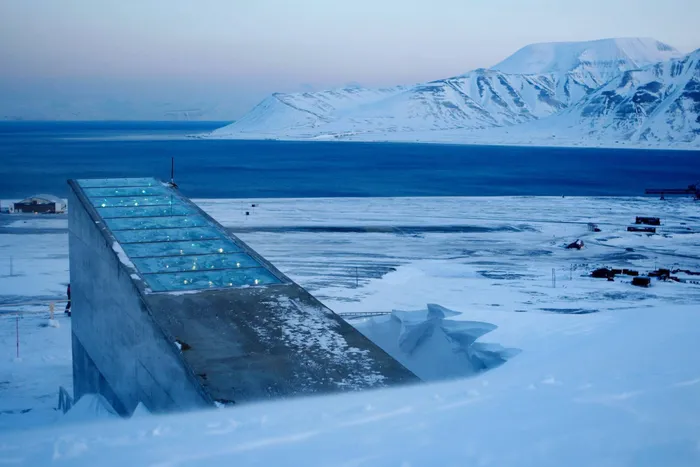Arctic vault safeguards seeds from extinction

DEEP FREEZE: This 2008 photo shows the Svalbard Global Seed Vault near Longyearbyen in Svalbard, Norway. DEEP FREEZE: This 2008 photo shows the Svalbard Global Seed Vault near Longyearbyen in Svalbard, Norway.
Some 2 100km into the Arctic Circle and just 1 050km from the North Pole lies the world’s most important freezer.
Situated on Spitsbergen Island in the Svalbard archipelago, the Global Seed Vault is owned by the Norwegian government and sits next to the world’s northernmost town, Longyearbyen, with a population of just over 2000.
Contained within in it are 930000 varieties of the world’s most precious seeds, sent by the gene banks across the globe to insure them against risks in their home country, such as natural disasters, war and looting.
Built to house as many as 5 million seed varieties, in the most extreme circumstances, the vault is intended to act as a “doomsday” depository for global agriculture if a major catastrophe wipes out the plants we rely on.
But its main role is in protecting diversity from threats that already exist today.
“Today, climate change is challenging agricultural production,” says Marie Haga, a former leader of Norway’s Centre Party and the executive director of the Crop Trust, which advises on and part-funds the vault.
“Plants have always adapted. Wheat originates in the Middle East and now we grow it all over the world, but it has taken thousands of years for wheat to move from the Middle East to somewhere like Canada. The basic problem today is that climate change is happening faster than plants are able to adapt.
“The primary aim of the vault is to ensure that mankind has access to a maximum diversity of crops to be able to adapt to new challenges in the future,” Haga says.
According to Kew’s State of the World’s Plants report, there are 90000 plant species known to science, with around 30000 used by people. Their report estimated that one in five plants are at risk from extinction, with habitat loss the leading cause of extinction risk.
“We are losing genetic diversity rapidly, both in the field and in gene banks around the world,” says Haga. “For each variety of seeds that we lose we also lose options for the future.”
Three vaults lie at the end of a 130m tunnel inside the flank of Mount Plateau, allowing the seeds to be stored deep within the Arctic permafrost. In the vault room the seeds are cooled to an optimal 18°C.
Three times a year this unique facility opens up its doors to allow countries to make deposits in the frozen vaults. Flown in by air to the world’s northernmost airport, any collaborating gene bank has to send over at least 500 examples of a given crop variety and remain proprietors of their seeds, should they ever need them.
To the surprise of many, the bank has already been used for its intended purpose. After the International Gene Bank of Syria determined their Aleppo site was too hard to administer in 2015, the site’s administrators requested their boxes from the vault to replenish new research facilities in Lebanon and Morocco.
It may seem like a rarefied endeavour, but there are 1700 gene banks dotted across the world, and many are considered to be at risk as a result of lack of funding, poor infrastructure, and not enough or qualified technical human resources or information systems.
In Afghanistan, two of the country’s seed banks have been looted, not for the seeds, but for the plastic containers used to store them. Hurricane Xangsane wiped out another bank in the Philippines.
“We have also lost seed collections in Iraq due to the war,” says Haga. “In China today, they only use 10% of the rice varieties they would have used back in 1950. In the US they have lost more than 90% of their fruit and vegetable varieties in the field. So it’s very important that this material exists in gene banks, and it’s vitally important that we have back-up systems.”
Locating the seed bank deep inside a mountain in the Arctic Circle is both an important security feature of Svalbard, and failsafe if the cooling system no longer works. If the power supply is cut off or the refrigeration units fail, the inside of the mountain would maintain a steady temperature of 5°C to 8°C.
Although not all the seeds would be saved, a feasibility study suggested many of the deposits would last for hundreds if not thousands of years, without human intervention.
Mount Plateau is also geologically stable with limited humidity and with low radiation readings inside the mountain itself. The Norwegian government, which owns the vault, says it has a “virtually infinite lifetime” and is “robustly secured against external hazards and climate change effects”. It certainly seemed to be the perfect site for this endeavour.
However, the government had not expected what has proved to be the hottest year on record, resulting in extreme weather conditions in the Arctic.
Despite having been positioned in an area where ice is supposed to remain frozen all year round, in May this year the permafrost melted, breached the bank’s entry doors and caused water to enter the facility’s 130m-long entrance tunnel. Fortunately, none of the seeds were affected by the meltwater as it refroze before it could reach the vault.